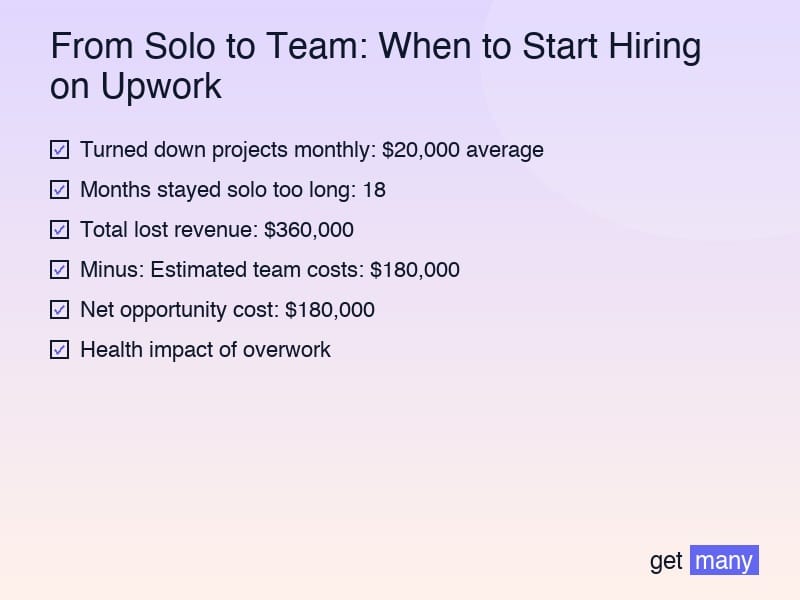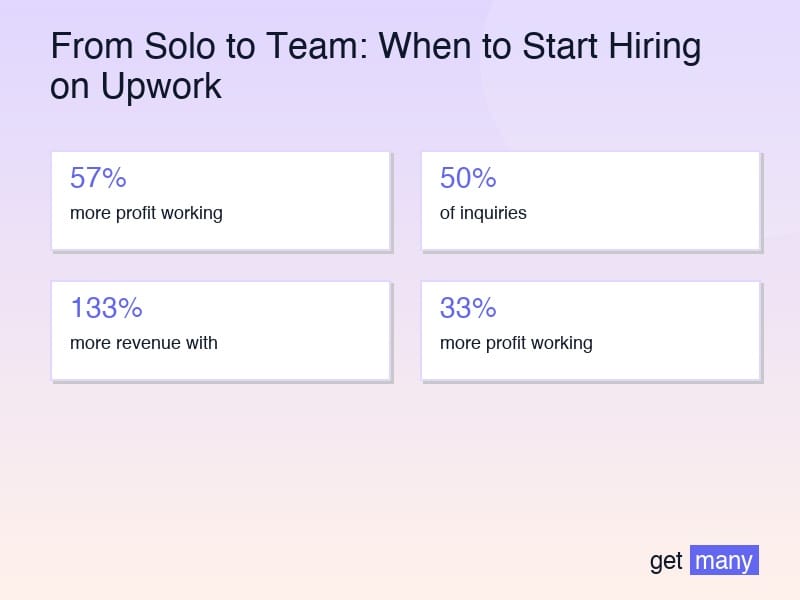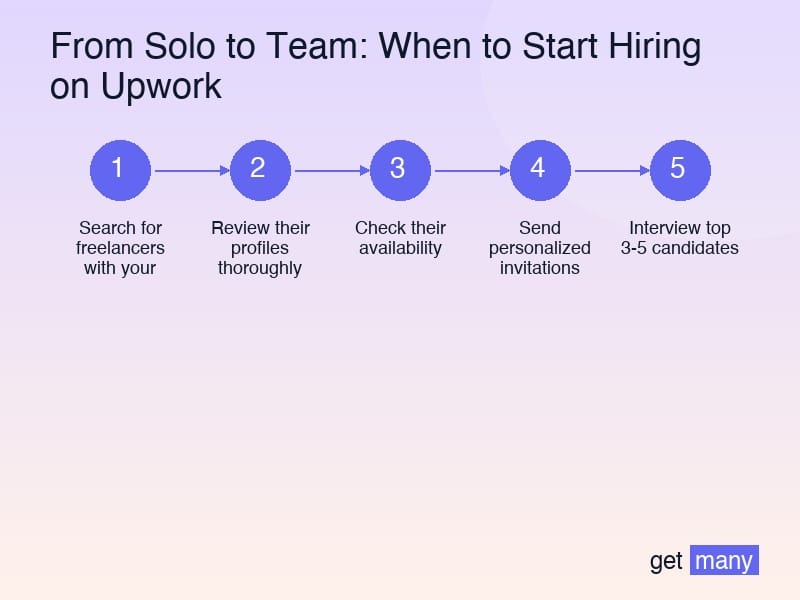7 August, 2025

Author
Kyrylo Kozak
From Solo to Team: When to Start Hiring on Upwork
For two years, I was the classic overworked freelancer. Working 70-hour weeks, turning down great clients, watching my health deteriorate while my business stagnated at $15,000 per month.
Then I finally hired my first team member. Within 90 days, revenue jumped to $35,000 monthly while I worked 40 hours instead of 70.
The painful truth? I should have hired 18 months earlier. That delay cost me at least $180,000 in lost revenue.
After helping 200+ freelancers build successful teams, I've identified the exact signals that indicate it's time to hire - and the framework for doing it profitably.
The Hidden Cost of Staying Solo

Before diving into when to hire, let's quantify what staying solo really costs:
The Opportunity Cost Calculator:
- Turned down projects monthly: $20,000 average
- Months stayed solo too long: 18
- Total lost revenue: $360,000
- Minus: Estimated team costs: $180,000
- Net opportunity cost: $180,000
But revenue is just the beginning...
The Complete Solo Penalty:
- Health impact of overwork
- Relationship strain from always working
- Creative burnout from repetitive tasks
- Strategic thinking time: Zero
- Business development: Neglected
- Skill development: Stagnant
The 7 Signals You're Ready to Hire

Signal 1: The Revenue Threshold
The 3X Rule: When your monthly revenue consistently exceeds 3x your target team member's cost.
Example:
- Your revenue: $15,000/month
- Developer cost: $4,000/month
- Ratio: 3.75x ✓
This ensures profitability even with training time and management overhead.
Signal 2: The Pipeline Overflow
Tracking Metrics:
- Qualified leads turned away: 3+ monthly
- Average value of declined projects: $5,000+
- Time to respond to opportunities: >24 hours
- Win rate declining due to slow response
If you're saying "no" to good money, you need help.
Signal 3: The Time Allocation Crisis
Document one week honestly:
- Billable work: >50 hours
- Admin tasks: >10 hours
- Business development: <5 hours
- Strategic planning: ~0 hours
When billable work consumes everything, growth stops.
Signal 4: The Quality Compromise
Warning Signs:
- Rushing deliverables
- Cutting corners on process
- Client satisfaction dropping
- Revision requests increasing
- Missing your own standards
Better to share profits than lose reputation.
Signal 5: The Health Indicators
Physical Signals:
- Working weekends consistently
- Sleep under 7 hours nightly
- Skipping exercise/meals
- Stress-related health issues
- Relationship conflicts about work
Your business shouldn't cost your life.
Signal 6: The Strategic Vacuum
Questions You Can't Answer:
- What's your 12-month growth plan?
- Which services should you expand?
- How are competitors evolving?
- What new skills do you need?
- Where's your industry heading?
If you're too busy to think strategically, you're not building a business.
Signal 7: The Scalability Wall
Growth Stagnation Metrics:
- Revenue flat for 3+ months
- Same client types repeatedly
- No service innovation
- Referrals declining
- Market share static
Solo has a ceiling. Teams break through.
The Financial Framework for First Hires

The Unit Economics Model
Before Hiring:
- Revenue: $15,000
- Your hourly rate: $125
- Hours worked: 120
- Profit margin: 85%
- Monthly profit: $12,750
After Strategic Hiring:
- Revenue: $30,000 (2x growth)
- Your hours: 80 (33% reduction)
- Team cost: $8,000
- Other costs: $2,000
- Profit margin: 67%
- Monthly profit: $20,000
Result: 57% more profit working 33% less.
The Investment Timeline
Month 1-2: Training Investment
- Revenue impact: -20%
- Time investment: 30 hours
- Financial cost: $8,000
- Learning curve: High
Month 3-4: Productivity Gains
- Revenue impact: +10%
- Time saved: 20 hours
- Quality improving
- Systems developing
Month 5-6: Full ROI
- Revenue impact: +50%+
- Time saved: 40 hours
- New opportunities captured
- Scaling foundation built
The Risk Mitigation Strategy
Start Small and Safe:
Phase 1: Project-Based Testing
- Hire for single project
- Evaluate communication
- Assess quality standards
- Test cultural fit
- Minimal commitment
Phase 2: Part-Time Transition
- 20 hours/week commitment
- Gradual responsibility increase
- Build trust incrementally
- Maintain flexibility
- Lower risk exposure
Phase 3: Full-Time Integration
- Proven performance record
- Clear role definition
- Established systems
- Mutual commitment
- Maximum impact
The Hiring Decision Matrix
Who to Hire First
Option A: Clone Yourself (Most Common)
- Hire: Someone with your core skills
- Benefit: Immediate capacity increase
- Risk: Limited growth diversity
- Best for: Service businesses
Option B: Complement Yourself (Recommended)
- Hire: Skills you lack or dislike
- Benefit: Service expansion
- Risk: Management complexity
- Best for: Growth-focused agencies
Option C: Multiply Yourself
- Hire: Administrative/project manager
- Benefit: Leverage your expertise
- Risk: Delayed revenue impact
- Best for: Complex projects
The Role Priority Framework
Analyze Your Time Log:
High-Value Activities (You Keep):
- Client strategy sessions
- Complex problem-solving
- Business development
- Key relationships
- Innovation work
Delegatable Activities (They Do):
- Routine development/design
- Quality assurance
- Documentation
- Basic client communication
- Administrative tasks
Calculate Delegation ROI: If delegating 40 hours saves you $5,000 in opportunity cost, paying $2,000 for help nets $3,000 profit.
Finding Your First Team Member
The Upwork Advantage
Why Hire Through Upwork:
- Payment protection built-in
- Performance history visible
- Easy contract management
- Global talent access
- Trial periods simple
The Reverse Job Post Method:
Instead of waiting for applications, actively recruit:
- Search for freelancers with your criteria
- Review their profiles thoroughly
- Check their availability
- Send personalized invitations
- Interview top 3-5 candidates
The Interview Framework
Round 1: Skills Assessment (30 minutes)
- Technical competency test
- Portfolio review
- Communication evaluation
- Rate expectations
- Availability confirmation
Round 2: Cultural Fit (45 minutes)
- Work style preferences
- Communication expectations
- Growth ambitions
- Team collaboration
- Long-term vision
Round 3: Paid Trial (1 week)
- Real project work
- Daily communication
- Process following
- Quality delivery
- Initiative demonstration
The Onboarding Excellence System
Week 1: Foundation Setting
- Tool access and setup
- Process documentation
- Communication protocols
- Quality standards
- First small project
Week 2-4: Guided Practice
- Daily check-ins
- Incremental responsibility
- Feedback loops
- System refinement
- Confidence building
Month 2: Measured Independence
- Weekly check-ins
- Autonomous projects
- Quality monitoring
- Process optimization
- Relationship deepening
The Management Transition
From Doer to Leader
The Mindset Shifts Required:
Old: "I can do it faster myself" New: "Teaching creates leverage"
Old: "Perfection is required" New: "85% quality at 2x speed wins"
Old: "I must control everything" New: "Trust with verification"
Old: "Hiring is expensive" New: "Not hiring is more expensive"
The Time Investment Reality
Your New Time Allocation:
- Direct work: 50% (down from 90%)
- Team management: 20%
- Business development: 15%
- Strategic planning: 10%
- Personal development: 5%
Initial management time seems high but pays exponential dividends.
The Communication Architecture
Daily Rhythms:
- Morning sync: 15 minutes
- End-of-day update: Email
- Quick questions: Slack/Discord
- Urgent issues: Phone
Weekly Structures:
- Monday planning: 60 minutes
- Wednesday check-in: 30 minutes
- Friday review: 45 minutes
Monthly Practices:
- Performance review
- Goal setting
- Process improvement
- Relationship building
Common First-Hire Mistakes
Mistake 1: Hiring Too Late
Cost: Lost opportunities, burnout, stagnation Solution: Track the 7 signals monthly
Mistake 2: Hiring Too Cheap
Cost: Poor quality, constant re-training, reputation damage Solution: Budget for 70th percentile talent
Mistake 3: Insufficient Onboarding
Cost: Slow productivity, frustration, early turnover Solution: Invest 40 hours in first month
Mistake 4: Micromanagement
Cost: No leverage gained, team frustration Solution: Define outcomes, not methods
Mistake 5: No Systems
Cost: Inconsistent quality, knowledge loss Solution: Document everything iteratively
Success Stories: The Transformation
Case Study 1: The Developer's Leverage
Before: $12K/month, 70 hours/week, declining health First Hire: Junior developer at $3K/month After 6 Months: $45K/month, 40 hours/week, 3-person team Key Lesson: Started with simple tasks, gradually increased complexity
Case Study 2: The Designer's Scale
Before: $8K/month, turning away 50% of inquiries First Hire: Production designer at $2.5K/month After 6 Months: $32K/month, launched new service line Key Lesson: Complementary hire enabled service expansion
Case Study 3: The Consultant's Multiplication
Before: $20K/month, zero strategic time First Hire: Project manager at $4K/month After 6 Months: $65K/month, 5-person team Key Lesson: Administrative hire created maximum leverage
Your 30-Day Hiring Action Plan
Week 1: Decision Analysis
- Track all 7 readiness signals
- Calculate opportunity costs
- Define ideal team member
- Set budget parameters
- Commit to timeline
Week 2: Preparation
- Document key processes
- Create training materials
- Set up collaboration tools
- Write job description
- Define success metrics
Week 3: Recruitment
- Post job or search profiles
- Review 20+ candidates
- Interview top 5
- Check references
- Make selection
Week 4: Onboarding
- Start with paid trial
- Daily check-ins
- Provide constant feedback
- Refine processes
- Build relationship
The Compound Effect of Team Building
Year 1 Solo: $180K revenue, 3,000 hours worked Year 1 with Team: $420K revenue, 2,000 hours worked
That's 133% more revenue with 33% less work.
But the real magic happens in years 2-5 as systems compound and teams mature.
The Fear That Stops Most Freelancers
"What if I can't keep them busy?" "What if quality suffers?" "What if clients don't like them?" "What if I'm not a good manager?"
These fears are real but manageable. Every successful agency owner faced them and pushed through.
The bigger risk is staying solo forever.
Your Next Steps
If even 3 of the 7 signals resonate, you're ready. Here's what to do today:
- Calculate your opportunity cost of staying solo
- Define your ideal first hire profile
- Set a hiring deadline (within 60 days)
- Start documenting your processes
- Begin building your financial buffer
The transition from solo freelancer to team leader is the most important leap in building a real business. It's scary, it's challenging, and it's absolutely worth it.
Stop trading time for money. Start building a business that scales.
Your future team is out there, ready to help you grow. The only question is: will you let fear keep you solo, or will you take the leap that transforms everything?
The best time to hire was probably 6 months ago. The second-best time is now.





